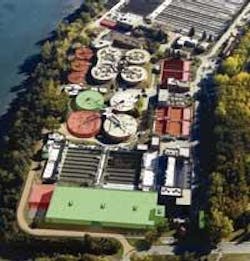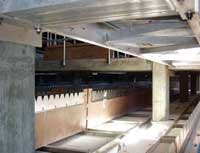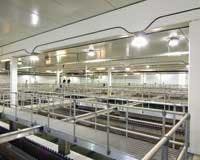Light Precast Concrete Troughs Offer Stainless Steel Alternative
A recent project to upgrade clarifier troughs at the Gold Bar Wastewater Treatment Plant in Edmonton, AB, Canada, was the first application of its kind to make use of ultra–high–performance (UHP) fiber–reinforced precast concrete.
Lying east of the Rocky Mountains and north of Calgary, Edmonton is the capital of Alberta, Canada, and the sixth largest metropolitan area in Canada. Situated among parklands in the North Saskatchewan River Valley, Edmonton’s wastewater receives tertiary treatment at the Gold Bar plant, where a recent expansion demonstrates the potential for next–generation technologies initiated in the precast concrete industry.
Gold Bar is situated on 48 acres along the shore of the North Saskatchewan River and is bounded by extensive city parks with over 93 mile of nature trails. Edmonton’s North Saskatchewan River Valley is the largest urban parkland in North America, encompassing 18,300 acre. This location within exceptional urban recreation and park resources makes the plant’s tertiary treatment of municipal wastewater of regional importance in maintaining water quality.
In addition to being at the forefront of wastewater treatment technology, Gold Bar is the first facility in the world to incorporate clarifier troughs made with Ductal UHP fiber–reinforced precast concrete. Ductal is Lafarge North America’s range of patented UHP concretes with ductile characteristics.
Stantec Consulting Ltd. of Edmonton, the City of Edmonton’s design and engineering consultants for the owner, recommended the original design for the Gold Bar expansion. Initial plans called for stainless–steel clarifier troughs in lieu of standard precast concrete due to weight restrictions. During the design phase, however, market indicators warned of materials shortages and impending cost increases in the steel manufacturing industry.
As a result of an earlier presentation on UHP fiber–reinforced precast concrete by Lafarge Canada, Stantec invited Lafarge to submit alternative designs for the Gold Bar plant expansion.
Weight limitations
The original specifications for stainless–steel clarifiers called for both superior durability in service and restrictions on dead weight for the troughs. Because the clarifier troughs sit on top of inclined plate frames, the weight of the troughs is restricted by the limited support capacity of the frames.
In its application at the treatment plant, the precast concrete uses steel fibers for reinforcement, which permits the creation of remarkably thin products with strengths comparable to steel–bar–reinforced concrete and stainless steel.
Photo courtesy of Tucker Photography.
Design engineers were able to take advantage of those properties to effectively replace the original, 0.25–inch–thick, U–shaped, stainless–steel clarifier troughs with precast troughs with a thickness of 0.7 in. and a cross section of 2 ft × 2 ft. A precast troughs weigh about 10 lb/ft2. A 15 ft trough weighs 840 lb, which was slightly less than the originally planned stainless–steel troughs.
Photo courtesy of Tucker Photography.
Altogether, about 3300 ft of UHP fiber–reinforced precast concrete clarifier troughs was installed in the Gold Bar plant expansion. While the strength to weight was an important consideration, stainless steel was significantly more expensive than any of the other material options, and the owner decided to use precast concrete for economic reasons more than equipment weight restrictions.
Production Tolerances
Much tighter production tolerances are required when casting thin sections of UHP fiber–reinforced concrete with a wall thickness of 0.7 in. Application of typical precast concrete manufacturing tolerances, commonly specified as –3.0 mm (–0.125 in.) and +6.5 mm (+0.25 in.), would represent about 15% to 30% of the trough wall thickness —tolerances that are unacceptably large for fabrication of the thin–walled troughs. For trough production, precast specialty engineers Kassian Dyck and Associates of Calgary specified a wall thickness tolerance of ±0.100 mm (4 mil).
UHP fiber–reinforced concrete casting must be allowed to shrink unrestrained as the concrete transitions from a fresh to a hardened state. Essentially, this means that the form must support the precast product while allowing shrinkage to occur. Therefore, the contractor for the clarifier troughs elected to cast the trough orientation opposite that of the installed product by using a form designed with a mechanism that allows complete rotation.
The trough mold was initially filled as an upside–down U shape, and a top, or cover, was installed to close the mold. The form’s cover contained windows through which the mold was topped off with the concrete mix. When the form was filled and before it was rotated to a right–side–up orientation, a slight positive hydrostatic pressure was introduced and maintained on the fresh concrete until initial set was achieved. The inner form was then removed to allow for shrinkage while the outer form remained in place to support the product.
The trough elements were tightly covered with plastic to prevent warping within the slender sections. Warping could result from differential rates of evaporation between the exposed inner faces of the trough and the form–covered outer surfaces during production. When the product reached release strength, a specially designed lifting device engaged the holes that would be used to connect the steel weir plates. This design eliminated the need to cast lift hooks or inserts for transport and erection.
The toughest challenge in designing the troughs was calculating the most efficient way to dissipate the point loads created by buoyancy forces at the tie–down locations. The stiffness of the stainless–steel anchor plates served to distribute the point loads as well as compensate for any localized thickening of the UHP fiber–reinforced precast concrete.
Conclusion
UHP fiber–reinforced precast concrete’s material characteristics are verified by extensive testing at the federal level for durable bridges of longer spans and less weight. Every expectation in the industry is that UHP fiber–reinforced precast concrete is the harbinger of not–as–yet–conceived structures and lightweight precast concrete elements of unprecedented thinness, strength, and durability.
By using the material’s combination of properties, designers can create thinner sections that are more graceful and innovative in geometry and form while providing improved ductility and impermeability against corrosion, abrasion, and impact.
Edmonton’s Gold Bar Wastewater Treatment Plant project illustrates the versatility of UHP fiber–reinforced precast concrete, proving its ability to meet the challenges faced by the owner and designers in a special–purpose and first–of–its–kind wastewater treatment application.
Designers chose state–of–the–art precast concrete material over a stainless–steel option without sacrificing the owner’s requirements, particularly the need for a low weight and corrosion resistance.WW
Editor’s Note:
For information on LaFarge UHP fiber–reinforced precast concrete and its potential uses in the water industry, contact Ignacio Cariaga at ignacio.cariaga@lafarge–na.com or visit the company’s website at www.lafarge–na.com.



